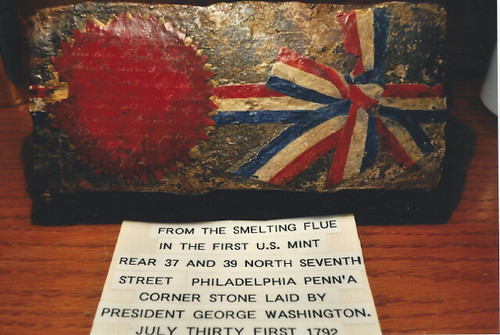
PREV ARTICLE
NEXT ARTICLE
FULL ISSUE
PREV FULL ISSUE
A PHILADELPHIA MINT CHIMNEY BRICK?
On a less scholarly track, Pete Smith, Len Augsburger and Joel Orosz shared an increasingly tongue-in-cheek exchange about a brick said to be from the first Philadelphia Mint. Someone sent the photo to Len after the August ANA convention.
-Editor

Provenance: "bought 20 years ago in an antique store in Ohio." Joel Orosz writes: The artistic license of the guy who painted the brick ought to be revoked, but getting past that, the label is interesting. It is in the style of pre-WWII museums, and it would appear that someone thought highly enough of its significance to carefully record the brick's provenance and put it in display. No way of knowing, of course, if it is a real first Mint brick, or if it indeed came from the chimney of the Rear Building, but certainly an interesting artifact of the Stewart demolition. Pete Smith writes: This might not be an artifact of the Stewart demolition. The Mint periodically disassembled the smelting furnace chimney to collect gold deposited on the bricks from vapors in the flue gasses. Someone may have found the brick interesting for that reason and preserved it while the Mint was still in operation. I believe it might be possible to confirm it is the right type of brick for the era. I see no way to prove its origin. Pete adds: I am working on a new theory. 1. The First United States Mint ceases operations in 1832. 2. The smelting furnace chimney is dismantled one last time and the bricks are cleaned and scraped to collect any trace of gold. 3. Samuel Moore takes some of the bricks home with him. He has them coated in shellac and painted with a red. white and blue ribbon. Some type of seal is added to the red spot, since missing. 5. Following his retirement from the Mint in 1835, Moore appears between acts at the local theater offering the bricks for sale. "As former Director of the Mint I can certify that this is an authentic gold brick taken from the United States Mint. It has been layered in .999 fine gold and encapsulated in a protective shield of shellac. This unique relic is preserved in Mint State, as fine today as the day it left the Mint. For a limited time only, this brick will be offered in the lobby of the theater following tonight's performance." I believe my theory fits all the known facts. Therefore, it must be true. Len Augsburger writes: Come to think of it, it would be very difficult to *disprove* your theory :) Joel Orosz writes: Not only is your theory undeniably true, the protective coating of shellac applied by Dr. Moore is extremely significant, for it demonstrates that Moore was the originator of the encapsulated numismatic artifact. I am willing to bet that further investigation will reveal that, after leaving the Mint, and before becoming the CEO of a coal company, Dr. Moore was the founding President of MBGS--Mint Brick Grading Service. I am convinced that its ultimate failure can be laid at the door of the stiffness of 19th century adjectives--instead of "blast white," Dr. Moore marketed bricks described as "Nearly, nay nigh unto red." Pete Smith writes: Yes, for silver coins, "blast white" is a desirable appearance. However, for copper coins, the standard is "brick red." Perhaps this is the red brick used to set that standard.
Kidding aside, for all we know this could well really be a brick from the first mint. Do any of our readers recall having seen it or something like it before? Do you know of any references to such a brick in the literature or some museum's inventory?
-Editor

Wayne Homren, Editor The Numismatic Bibliomania Society is a non-profit organization promoting numismatic literature. See our web site at coinbooks.org. To submit items for publication in The E-Sylum, write to the Editor at this address: whomren@gmail.com To subscribe go to: https://my.binhost.com/lists/listinfo/esylum All Rights Reserved. NBS Home Page Contact the NBS webmaster 
|